Streamlining Transaction Matching in Oracle ARCS: A Deep Dive into Adjustments and Reconciliation Balancing
Nadia Lodroman | Oracle EPM Consultant | Integrity in Every Insight.
4 April 2025
Listen to Tresora and Ledgeron's chatting about this blog post:
Navigating the Adjustment Paradox in Oracle ARCS Transaction Matching
Oracle Account Reconciliation Cloud Service (ARCS)
is a powerful tool for streamlining reconciliation processes. Its Transaction Matching feature is particularly useful for comparing large volumes of data, identifying discrepancies, and ensuring accuracy. However, like any sophisticated system, it presents unique challenges that require careful navigation. One such challenge revolves around the use of adjustments and their impact on reconciliation balance.
The Purpose of Adjustments
In ARCS Transaction Matching, adjustments serve a crucial role: they allow users to reclassify items that shouldn't be part of the core reconciliation. This is particularly useful for items that need to be moved to a different account or require further investigation outside the standard matching process.
The Balancing Act: When Adjustments Throw Things Off
The problem arises when these adjustments are confirmed. While they correctly reclassify the items, they often cause the reconciliation to become out of balance. This is because ARCS treats these adjustments as real transactions, affecting the overall balance.
The Subsequent Correction: A Double Adjustment
To rectify this imbalance, users typically need to import an adjustment journal in the next transaction import cycle. This journal reclassifies the initial adjustment, effectively offsetting its impact on the reconciliation balance. However, this correction adjustment is often purely for ARCS purposes and doesn't require posting in the Enterprise Resource Planning (ERP) system.
Why This Happens and How to Manage It
Understanding why this occurs is essential for effective management:
ARCS Accounting Treatment:
ARCS processes adjustments as actual accounting entries within the reconciliation, impacting the balance.
ERP vs. ARCS:
The ERP may not require these adjustments, leading to a disconnect between the two systems.
Best Practices and Recommendations
Here are some best practices to manage this situation:
- Clear Documentation: Maintain detailed documentation of all adjustments, including the reason for the adjustment and whether it requires an offsetting entry in the next cycle.
- Naming Conventions: Implement clear naming conventions for adjustment journals to distinguish between ERP-required and ARCS-specific adjustments. For Example, using a prefix such as "ARCS_ADJ" for adjustments that only exist for ARCS.
- Regular Reconciliation Reviews: Conduct regular reviews of reconciliation balances and adjustment activity to identify and correct any imbalances promptly.
- Process Standardisation: Establish a standardised process for handling adjustments, ensuring consistency across all reconciliations.
- Leverage Comments and Explanations: Use the comments and explanation fields within ARCS to provide context for each adjustment, making it easier to track and understand.
- Consider Custom Attributes: Explore using custom attributes in ARCS to flag adjustments that don't need ERP posting, streamlining the identification process.
- Training: Ensure all users are thoroughly trained on the adjustment process and understand the implications of confirming adjustments.
- Automation: If possible and if your organization uses EPM automate, create scripts that can automatically create and import these offsetting adjustment journals.
The Importance of Communication
Effective communication between the reconciliation team and the ERP team is vital. Ensuring that both teams understand the nature of these ARCS-specific adjustments can prevent confusion and streamline the reconciliation process.
Conclusion
While the adjustment paradox in Oracle ARCS Transaction Matching can be challenging, understanding the root cause and implementing best practices can help users maintain accurate and balanced reconciliations. By prioritising clear documentation, standardised processes, and effective communication, organisations can leverage the full potential of ARCS while minimising the impact of these unique adjustment scenarios.
Turning financial complexity into operational clarity. Because in Finance, Integrity is Permanent.






